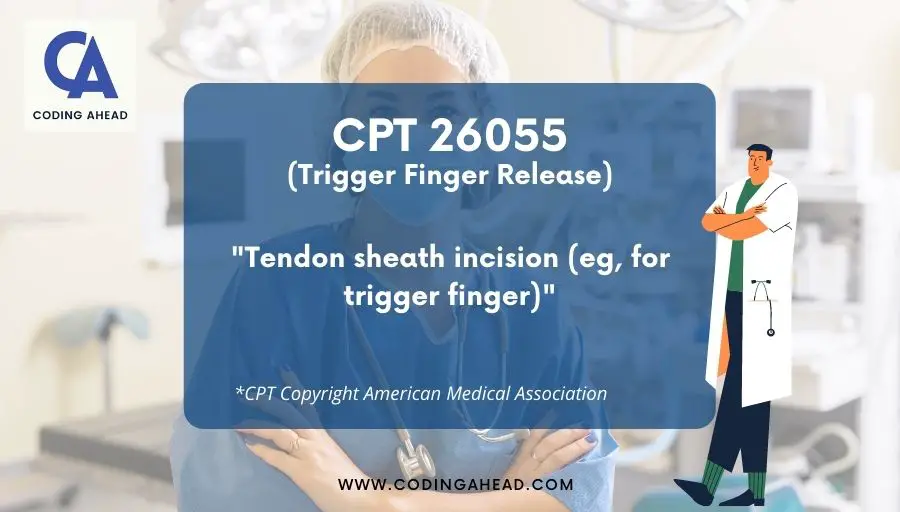(2023) Trigger Finger Release CPT Code 26055 | Description, Guidelines, Reimbursement, Modifiers & Examples
Trigger finger release CPT code 26055 can be reported for stenosing tenosynovitis by incising the tendon sheath at the finger’s base.
Trigger finger issue comes to the limelight when a finger stays in a stiff bent position for some time due to swollen tendon or inflammation, narrowing of A1 pulley, or formation of nodules among the tendon.
Trigger finger problem has to be resolved by employing a well-skilled surgeon to perform such a delicate task of treating it precisely.
Trigger finger release CPT code 26055 can only be performed by a specialty surgeon. The specialty surgeon and coder must also consider all the required CPT (Current Procedural Terminology) codes involved in this operative procedure. This is the only way to get their reimbursement for the job done.
Trigger Finger Release | CPT Code 26055 | Description & Procedure
The CPT 26055 describes trigger finger release. However, the 26055 CPT code also includes inclusions like all other CPT codes.
The official description of CPT code 26055 is: “Tendon sheath incision (e.g., for trigger finger).”

CPT 26055 is a standard and preferable surgical procedure that revitalizes the mobility of stiff fingers caused by a trigger finger.
However, the finger remains contracted and pains when the patient uses those extensor tendons. Therefore, a specialty surgeon performs this surgery under local anesthesia.
A mild sedative may be introduced intravenously (IV), and local anesthesia would numb the area. Once the anesthesia takes effect on the body, the surgeon starts the course of surgery he has already devised to relieve the patient.
The surgeon must first locate the problematic tendon sheath and create a small incision of merely ½ inch (the size of an incision may vary depending on the case) on the dermal tissue at the base of the affected finger flexion crease at the palm of a hand, to produce enough room for tendon visualization and movement.
Next, the surgeon cuts the tendon sheath (A1 pulley), which impedes mobility if swollen. The whole sectioning of the A1 pulley is compulsory to retain the mobility of the digit.
The cut is made proximal to the base of the finger flexion crease, and the tendon releases pressure. This cut preserves not only the A2 pulley but also the NV bundle.
The physician has to make sure that the finger moves smoothly and freely. After being convinced, the respective area is carefully stitched before the anaesthesia wears off.
Then, the patient should move the finger freely right after the numbness is gone. This way, the physician or the surgeon makes an all-out effort to stick to the variables outlined to treat the patient by employing the available and applicable medical amenities.
This is done for the object of, later on, getting paid by the cover company, the government payers, or the commercial payers.
Here, the physician’s task is to employ the required CPT codes and then mention them to the coder to make their task more accessible and to the point.
CPT 26055 aftercare includes using a properly sanitized bandage, using a dry ice pouch for a short time, preferably 5 minutes a day, to avoid any infection, and reducing pain if caused by the stitches.
In addition, an ice patch would keep the finger and palm from being sore. Routine exercises are also recommended in most cases.
The percutaneous trigger finger release is due to the contraction of the A1 pulley because of the disturbance in the Metacarpophalangeal joint, causing the shifting of NV structures dorsally.
The area is made numb, a needle is introduced into the skin and A1 pulley, tendon sheath is cut, and the finger extends smoothly.
As there was no incision in the first place, no stitches were required, and the cut sheath would grow itself.
However, this procedure has some risk of Neurovascular damage mainly because of poor visualization, but still, this procedure has a 90% success rate.
CPT 26055 has complications depending on the surgeon’s skill, including incomplete cure, digital nerve injury, A2 pulley release with bowstringing, stiffness, vascular injury, wound maceration, and tendon tear.
The specialty surgeon must keep an eye on all the operation details, ensure that the procedure is done according to the set rules, and use all the CPT codes necessary to perform this operation.
Perfect consideration is given to the codes related to the operative procedure, as this will lead to the desired reimbursement amount in the long run.
CPT 26055 procedure is an efficient way of treating Trigger fingers as it provides a higher success rate and lesser iatrogenic neurovascular damage.
The cutoff tendon then grows back and provides the same efficient output unless there were any errors in the surgery, like a nonprofessional cut by the surgeon that may damage the neurovascular bundle (NV).
CPT 26055 and CPT 26460 treatments are related but must not be mistaken as they are not precisely similar. Therefore, it is highly recommended that the physician and the coder read the code specifications correctly.
This is the only way to reach the goal of the desired amount of correct compensation at the end of the day.
CPT 26055 is a surgical procedure that may involve an incision. It is only used for trigger finger release, while CPT 26460 involves the open tenotomy, the surgical division of the extensor tendon of the hand or finger.
Billing Guidelines
Tendon Sheath incision is billed depending on which service center has offered the service, whether Ambulatory Surgery Centre (ASC) or Hospital Outpatient Department.
The billing depends on the DOS (Date of Services), the POS (Place of Services), and the services performed.
This billing method is solely based on US Medicare official announced charges of the services. In addition, the procedure performed must prove a medical necessity.
A hospital has an outpatient department that treats outpatients who do not require a bed or an overnight stay and care. However, outpatient departments perform various services, including diagnostic tests and minor surgical procedures.
Reimbursement
Ambulatory Surgery Center (ASC) charges a total of $1023, including doctor fee and Facility fees per procedure and aftercare.
Out of this, the patient only has to pay $204 while US Medicare pays the other amount; the patient can undoubtedly benefit depending on the possession of the Medicare Advantage plan or supplemental insurance policy.
One must go through the guidelines issued by the American Medical Association before going ahead in this. In addition, the compensation rates may sometimes change for some commercial companies that cover medical facilities in the length and breadth of the USA.
While Hospital Outpatient departments charge an average of $1692 per procedure, patients pay about $338 while US Medicare reimburses the other amount.
The fares can vary upon possession of a Medicare Advantage Plan or Supplemental Insurance Policy.
The costs provided are national averages and cannot be considered a final word. Also, the CPT 26055 should be supported with the required medical documentation.
A mere CPT 26055 surgical procedure costs $483.19 on average.
This amount does not include the physician’s fee. More than one procedure for treatment and charges may vary following that.
Your supplemental insurance policy may cover your procedural costs. A bit of professional medical advice, diagnosis, or treatment is still advised, and this should be considered the only form of reliable information.
Modifiers
CPT 26055 does need some add-ups, like F modifiers, to specify the location. Modifier RT or LT to identify right or left depending on where the incision is made.
For example, the CPT 26055 modifier for the right middle finger would be F7.
If the procedure is performed on one or more fingers, it shows the physician’s increased period and increased physical and mental effort. In this case, modifier 51 may be appended.
Modifier 51 is used mainly for the same procedure performed on different sites on the same day and the same session and by the same physician.
The modifier 59 can also be appended to bypass the edits when performed with other services. As modifier 59 describes specific procedural services.
Modifier 59 is still preferred for the NCCI (National Correct Coding Initiative) edits.
Modifier 51 and modifier 59 are payment modifiers. Both can affect reimbursement significantly.
Examples
Below are two billing examples for trigger finger release CPT code 26055.
Example 1
A 55-year-old patient was diagnosed with a left ring trigger finger (F3).
A trigger finger release procedure is executed on the affected finger. First, the patient is given anesthesia, the A1 pulley is sectioned, and the incision part is stitched. Patient aftercare includes monitoring of finger movement.
Billing:
CPT Codes:
- CPT 26055: Tendon sheath incision (e.g., trigger finger release): This code is used for the trigger finger release procedure performed on the affected left ring finger.
ICD-10 Codes:
- ICD 10 M65.342: Trigger finger, left ring finger: This code documents the diagnosis of the left ring trigger finger.
Example 2
A 30-year-old patient has been diagnosed with a right middle trigger finger (F7).
A trigger finger procedure was performed on the patient, and all the necessities were met. However, the person may have acquired the problem because of extensive or heavy usage of the right hand, and inflammation may have occurred that kept the F7 in its flexor state.
Billing:
CPT Codes:
- CPT 26055: Tendon sheath incision (e.g., trigger finger): This code is used for the surgical procedure to treat the patient’s right middle trigger finger.
ICD-10 Codes:
- ICD 10 M65.331: Trigger finger, right middle finger: This code documents the patient’s diagnosis of a right middle trigger finger.



